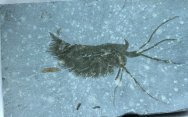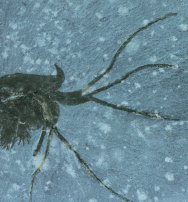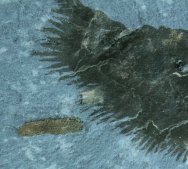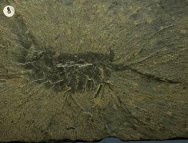Leanchoilia
superlata
Phylum Arthropoda
Vauxia gracilenta
Phylum Porifera,
Class Desmospongia, Order Verongida, Family Vauxiidae
Geological
Time: Early Cambrian, (~520 million years ago)
Size (25.4
mm = 1 inch): Leanchoilia: 95 mm overall including appebdages, body
55 mm; Vauxia: 12 mm by 3 mm; on a 134 mm by 83 mm matrix
Fossil Site:
Stephen Formation, Burgess Shale, Burgess Pass, British Columbia, Canada
Fossil Code:
JH39
Price: Sold
| 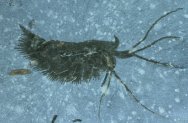 Description:
Leanchoilia superlata is an unusual arthropod found in the Burgess
Shale Fauna of British Columbia. It is a member of a group of “great
appendage arthropods” known as opabinids after the bizarre
Opabinia from the Burgess. It is possibly also known from Utah
and Greenland, and has an older relative Leanchoilia illecebrosa
found in the Chengjiang Biota of China (see my other offerings).
The contrast between the specimen and the matrix has been enhanced
by a chemical process that removed some of the matrix overburden.
I have included a “before” photo so you can see the
difference such treatment makes. Since the specimen is typically
covered with resistant mica and is composed of the carbonized
remains of the animal, it is inert to the treatment. The result
you see here is ALL NATURAL. There has been NO PAINT Description:
Leanchoilia superlata is an unusual arthropod found in the Burgess
Shale Fauna of British Columbia. It is a member of a group of “great
appendage arthropods” known as opabinids after the bizarre
Opabinia from the Burgess. It is possibly also known from Utah
and Greenland, and has an older relative Leanchoilia illecebrosa
found in the Chengjiang Biota of China (see my other offerings).
The contrast between the specimen and the matrix has been enhanced
by a chemical process that removed some of the matrix overburden.
I have included a “before” photo so you can see the
difference such treatment makes. Since the specimen is typically
covered with resistant mica and is composed of the carbonized
remains of the animal, it is inert to the treatment. The result
you see here is ALL NATURAL. There has been NO PAINT  added
to bring out detail. This wonderful example shows incredible
detail
for a specimen more than a HALF BILLION years of age. Notice
the upturned “snout,” the sweeping appendages, body
segments, and gut trace as well as the gill filaments of the
biramous swimming appendages. added
to bring out detail. This wonderful example shows incredible
detail
for a specimen more than a HALF BILLION years of age. Notice
the upturned “snout,” the sweeping appendages, body
segments, and gut trace as well as the gill filaments of the
biramous swimming appendages.
The
smaller fossil to the lower left is an unbranched example of
the sponge Vauxia. Unlike
all other Burgess sponges, this one is composed only of a spongin-like
material with no spicules. The fibers that made up the skeleton
are fused into a net affording a tough structure that preserved
well. If you look closely, you can see the pores present with
which the sponge took up water to filter out the particulates
upon which it fed. Coming from the famous Burgess Shale Fauna,
this is a highly-desirable member which will make a fine addition
to any collection of Cambrian Explosion fossils. It is also
quite rare: for each 1000 Burgess specimens only 2 are Leanchoilia;
even fewer are as complete as this excellent example. Since
the
location is now a World Heritage site only specimens from old
collections such as this are available.
|
|



